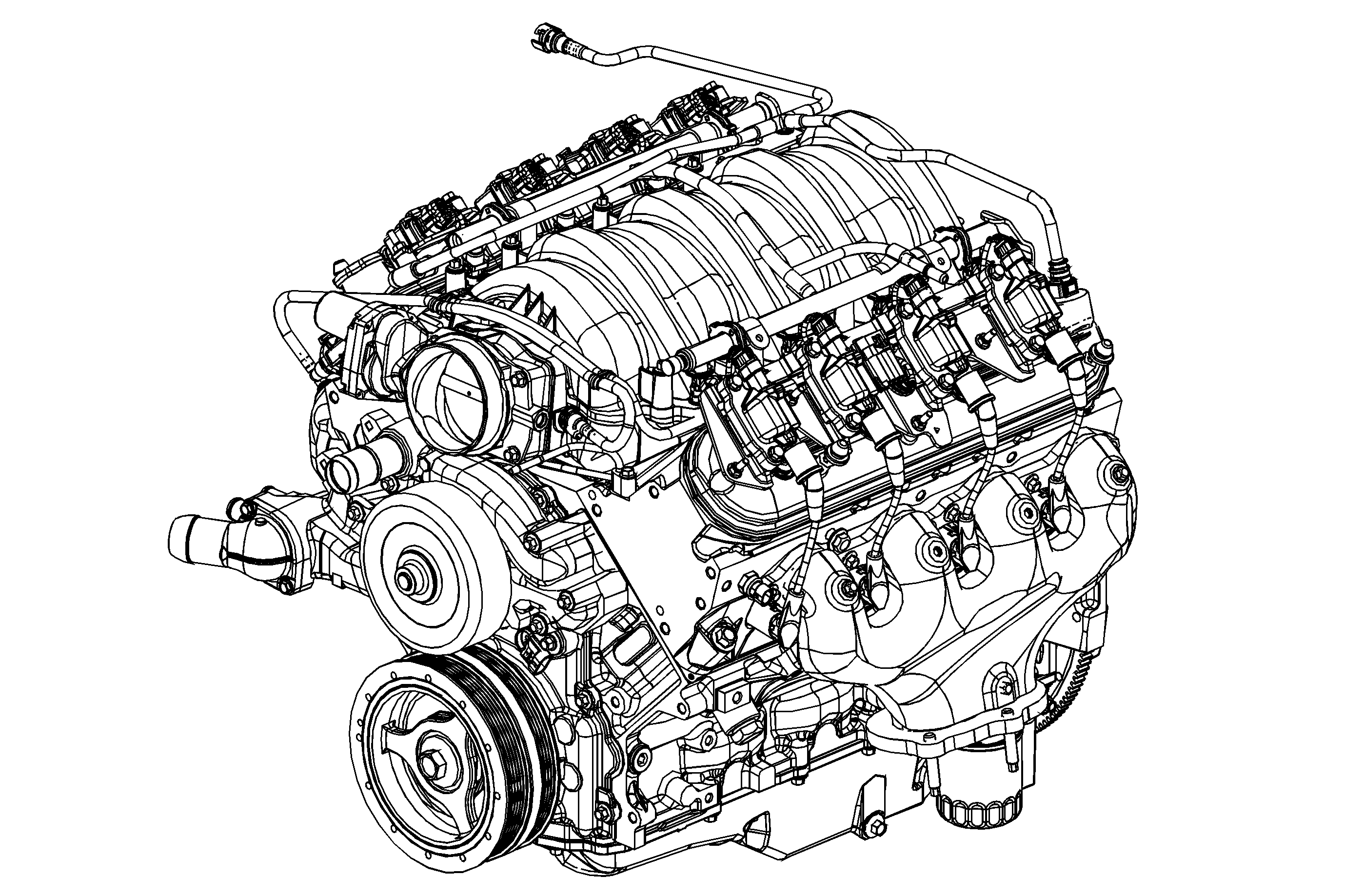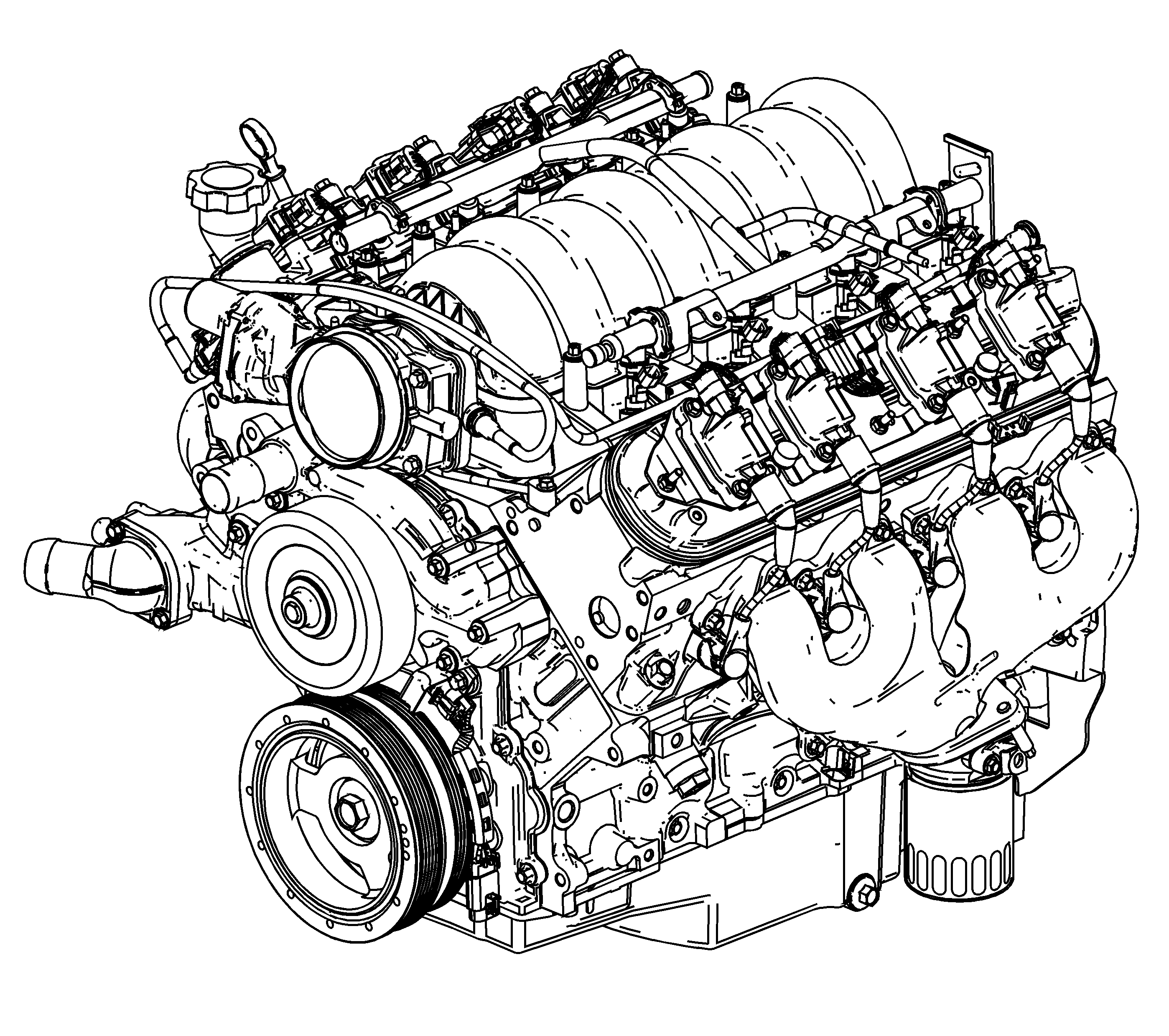Engine Component Description 7.0L
The 7.0 Liter V8 Engine

The 7.0 Liter V8 engine is identified as RPO LS7 VIN E.
Camshaft and Drive System
A billet steel 1 piece camshaft is supported by 5 bearings pressed into the engine block. The camshaft timing sprocket is mounted to the front of the camshaft and is driven by the crankshaft sprocket through the camshaft timing chain. The camshaft position (CMP) sensor lobes are incorporated into the front face of the camshaft sprocket, with the CMP sensor mounted to the engine front cover. A timing chain dampener is mounted to the front of the engine block above the crankshaft sprocket. The externally splined crankshaft sprocket is positioned to the crankshaft by a key and keyway. The crankshaft sprocket external splines drive the oil pump drive gears. A retaining plate mounted to the front of the engine block maintains camshaft location.
Crankshaft
The precision-balanced crankshaft is forged steel and is supported by 5 crankshaft bearings. The bearings are retained by forged steel crankshaft bearing caps, which are machined with the engine block for proper alignment and clearance. The crankshaft journals are undercut and rolled. The center main journal is the thrust journal. A crankshaft position (CKP) reluctor ring is press-fit mounted at the rear of the crankshaft. The reluctor ring is not serviceable separately.
Cylinder Heads
The cylinder heads are cast aluminum and include pressed-in-place powdered metal valve guides, 56 mm (2.20 in) diameter titanium intake valves, 41 mm (1.61 in) diameter sodium filled stem exhaust valves, and 70 cubic centimeter combustion chambers. Passages for the engine coolant air bleed system are at the front of each cylinder head. The valve rocker arm covers are retained to the cylinder heads by 4 center mounted rocker arm cover bolts.
Engine Block
The engine block is a cam-in-block deep skirt 90 degree V configuration with 5 forged steel crankshaft bearing caps. The engine block is cast aluminum with press-in-place iron cylinder liners. The 5 crankshaft bearing caps each have 4 vertical M10 and 2 horizontal M8 mounting bolts. The engine block and bearing caps are aligned by dowel pins retained in the caps. The camshaft is supported by 5 press-in-place camshaft bearings.
Exhaust Manifolds
The hydro-formed stainless steel exhaust headers are a 1 piece steel design with unique quad flow collector flanges. The exhaust manifolds direct exhaust gasses from the combustion chambers to the exhaust system. Each manifold also has an externally mounted heat shield that is retained by bolts.
Intake Manifold
The intake manifold is a friction welded 3 piece composite design that incorporates brass threaded inserts for mounting the fuel rail, throttle body, and wire harness studs. Each side of the intake manifold is sealed to the cylinder head by 4 non-reusable push-in-place silicone sealing gaskets. The 90 mm (3.54 in) electronically actuated throttle body bolts to the front of the intake manifold. The throttle body is sealed by a 1 piece push-in-place silicone gasket. The fuel rail assembly, with 8 separate fuel injectors, is retained to the intake by 4 bolts. The injectors are seated into their individual manifold bores with O-ring seals to provide sealing. 2 fuel rail stop brackets are retained to the rear of the intake manifold by mounting bolts. The manifold absolute pressure (MAP) sensor is installed and retained to the top front of the intake manifold and sealed by an O-ring seal. The evaporative (EVAP) emission canister purge solenoid valve is mounted to the front of the right cylinder head. There are no coolant passages within the intake manifold.
Oil Pan
The structural oil pan is cast aluminum. Incorporated into the design are the oil filter mounting boss, drain plug opening and internal oil passages. The alignment of the structural oil pan to the rear of the engine block and transmission housing is critical.
Piston and Connecting Rod Assembly
The pistons are cast aluminum. The pistons use 2 compression rings and 1 oil control ring assembly. The piston is a low friction, lightweight design with a recessed top and barrel shaped skirt. The piston pins are chromium steel and are a full-floating design. The connecting rods are forged titanium alloy with press-in-place piston pin bushings. The connecting rods and rod cap are aligned by dowel pins retained in the cap. All applications use a piston with a graphite coated skirt. The piston, pin, and connecting rod are to be serviced as an assembly.
Valve Rocker Arm Cover Assemblies
The valve rocker arm covers are cast aluminum and use a pre-molded silicon gasket for sealing. Mounted to each rocker cover is a coil and bracket assembly. Positive crankcase ventilation (PCV) fresh air passages are incorporated into both the left and right side covers. The cap on the right valve cover is not to be used for oil fill.
Valve Train
Motion is transmitted from the camshaft, through the hydraulic roller valve lifters and tubular pushrods, to the roller type rocker arms. The nylon valve lifter guides position and retain the valve lifters. The valve rocker arms for each bank of cylinders are mounted directly to the cylinder heads. Each rocker arm is retained to the cylinder head by a bolt. Valve lash is net build. The exhaust valves have sodium filled valve stems. The intake valves are a titanium design and have a rocker arm wear pad at the top of the stem.
Engine Component Description 6.2L
The 6.2 Liter V8 Engine

The 6.2 Liter V8 engine is identified as RPO LS3 VIN W.
Camshaft and Drive System
A hollow billet steel 1 piece camshaft is supported by 5 bearings pressed into the engine block. The camshaft timing sprocket is mounted to the front of the camshaft and is driven by the crankshaft sprocket through the camshaft timing chain. The camshaft position (CMP) sensor lobes are incorporated into the front face of the camshaft sprocket with the CMP sensor mounted in the engine front cover. A timing chain tensioner is mounted to the front of the engine block above the crankshaft sprocket. The externally splined crankshaft sprocket is positioned to the crankshaft by a key and keyway. The crankshaft sprocket external splines drive the oil pump drive gear. A retaining plate mounted to the front of the engine block maintains camshaft location.
Crankshaft
The crankshaft is cast iron. The crankshaft is supported by 5 crankshaft bearings. The bearings are retained by crankshaft bearing caps which are machined with the engine block for proper alignment and clearance. The crankshaft journals are undercut and rolled. The center main journal is the thrust journal. A crankshaft position (CKP) reluctor ring is press fit mounted at the rear of the crankshaft. The reluctor ring is not serviceable separately.
Cylinder Heads
The cylinder heads are cast aluminum and have pressed in place powdered metal valve guides and valve seats. Passages for the engine coolant air bleed system are at the front of each cylinder head. The valve rocker arm covers are retained to the cylinder heads by 4 center mounted rocker arm cover bolts. High-flow cylinder heads, similar to the L92 truck application, with modified intake and exhaust ports are used to increase flow.
Engine Block
The new larger bore engine block is a cam-in-block deep skirt 90 degree V configuration with 5 crankshaft bearing caps. The engine block is cast aluminum. The 5 crankshaft bearing caps each have 4 vertical M10 and 2 horizontal M8 mounting bolts. The camshaft is supported by 5 camshaft bearings pressed into the block.
Exhaust Manifolds
The exhaust manifolds are a 1 piece cast iron design. The exhaust manifolds direct exhaust gasses from the combustion chambers to the exhaust system. Each manifold also has an externally mounted heat shield that is retained by bolts. The cylinder head intake and exhaust ports have been modified to increase flow. Also now available in the Corvette with LS3 is a butterfly valve in the exhaust system, RPO NPP, which opens at high exhaust flow levels and by-passes the tri-flow S-shaped path the exhaust gasses normally follow reducing exhaust restrictions.
Intake Manifold
The intake manifold is a 1 piece composite design that incorporates brass threaded inserts for mounting the fuel rail, throttle body, and wire harness studs. A non-serviceable cap with acoustic foam has been added to the top of the manifold to reduce engine noise. Each side of the intake manifold is sealed to the cylinder head by a non-reusable push-in-place silicone sealing gasket. The electronically actuated throttle body bolts to the front of the intake manifold. The throttle body is sealed by a 1 piece push-in-place silicone gasket. The fuel rail assembly, with 8 separate fuel injectors, is retained to the intake by 4 bolts. The injectors are seated into their individual manifold bores with O-ring seals to provide sealing. A fuel rail stop bracket is retained to the rear left of the intake manifold by mounting bolts. The manifold absolute pressure (MAP) sensor is installed and retained to the top front of the intake manifold and sealed by an O-ring seal. The evaporative emission (EVAP) canister purge solenoid valve is mounted to the front of the right cylinder head. There are no coolant passages within the intake manifold.
Oil Pan
The structural rear-sump oil pan is cast aluminum. Incorporated into the design is the oil filter mounting boss, drain plug opening and oil level indicator tube opening. The alignment of the structural oil pan to the rear of the engine block and transmission bell housing is critical.
Piston and Connecting Rod Assembly
The new larger diameter pistons are cast aluminum. The pistons use 2 compression rings and 1 oil control ring assembly. The piston is a low friction, lightweight design with a flat or recessed top and barrel shaped skirt. The piston pins are chromium steel and are a full-floating design. The connecting rods are powdered metal. The connecting rods are fractured at the connecting rod journal and then machined for the proper clearance. All applications use a piston with a graphite coated skirt. The piston and pin are to be serviced as an assembly.
Valve Rocker Arm Cover Assemblies
The valve rocker arm covers are cast aluminum and use a pre-molded silicon gasket for sealing. Mounted to each rocker cover are the coil and bracket assemblies. Incorporated into the right cover is the oil fill tube and the positive crankcase ventilation (PCV) fresh air passage.
Valve Train
Motion is transmitted from the camshaft through the hydraulic roller valve lifters and tubular pushrods to the roller type rocker arms. The nylon valve lifter guides position and retain the valve lifters. The valve rocker arms for each bank of cylinders are mounted on pivot supports. Each rocker arm is retained on the pivot support and cylinder head by a bolt. The inlet rocker arms are offset 6 mm (0.24 in) to enable more direct intake flow. Valve lash is net build.
